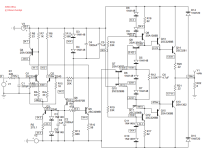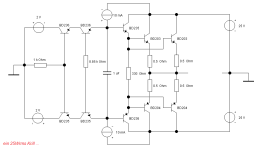I have to ask for a little patience, my schedule has been completely disrupted, it will take a while before I can offer measurement results of the preliminary final circuit from posting #482. It's always the little things in life that cause delays, even something as mundane as drilling the heatsink, I just can't get around to it at the moment.
But basically one thing is absolutely clear, the power amplifier is not biased correctly - and that's basically, stupidly, not even possible with the (or rather "this") Diamond configuration, even if L. Stellema tried. Even if this topology seems so promising, it simply isn't - I don't mean to say that this amplifier doesn't deliver completely satisfactory results (it will!), but that it is, or can be, technical nonsense.
With the six tiny power transistors available, you /we actually immediately build up the well-known shape, however the bias voltage is generated and adjusted is irrelevant in the first step - it can be "a krill", but it doesn't have to be one.
Sorry for delay,
HBt.
But basically one thing is absolutely clear, the power amplifier is not biased correctly - and that's basically, stupidly, not even possible with the (or rather "this") Diamond configuration, even if L. Stellema tried. Even if this topology seems so promising, it simply isn't - I don't mean to say that this amplifier doesn't deliver completely satisfactory results (it will!), but that it is, or can be, technical nonsense.
With the six tiny power transistors available, you /we actually immediately build up the well-known shape, however the bias voltage is generated and adjusted is irrelevant in the first step - it can be "a krill", but it doesn't have to be one.
Sorry for delay,
HBt.
Attachments
Krill the Drifter - I just think out loud (monologue)

Without forced symmetrization, i.e. locked in a global negativ feedback loop, such an ensemble becomes a Sisyphean task. But the bias is (now) right and the dimensioning can easily deliver 5A peakcurrent into the load.

Any objections from the off?
Maybe this class B power amplifier really doesn't switch off ... (whoever believes it!?).
Greetings,
HBt.
Without forced symmetrization, i.e. locked in a global negativ feedback loop, such an ensemble becomes a Sisyphean task. But the bias is (now) right and the dimensioning can easily deliver 5A peakcurrent into the load.
Any objections from the off?
Maybe this class B power amplifier really doesn't switch off ... (whoever believes it!?).
Greetings,
HBt.
Last edited:
Potentials must be correctly defined:
I assume that countless "Krill thinkers" have already reached this point.
If you let the circuit float you can see it clearly; potentials must be tightened.
Here is an example as food for thoughts, which also applies to the very simple diamond - a point that has annoyed me for weeks and yet is so obvious.

HBt.
I assume that countless "Krill thinkers" have already reached this point.
If you let the circuit float you can see it clearly; potentials must be tightened.
Here is an example as food for thoughts, which also applies to the very simple diamond - a point that has annoyed me for weeks and yet is so obvious.
HBt.
The crux of the matter
The base potential of
Saturation operation is the only way to convince yourself that Q2,3 & Q5,6 do not appear to be switched off at signal zero crossing. But it is precisely the correct (temporal) switching on and off of class B operation that is the whole secret of good sound. If set correctly, the Steve Dunlap bias shift can prevent this - but this also has its price (disadvantages).
In my opinion, you should do without Q9 and Q10, because the arrangement between the base_Q1 and base_Q4 nodes is still not thought through to the end.
The base potential of
- Q11 should be < 0V, i.e. negative
- Q12 should be > 0V, i.e. positive
Saturation operation is the only way to convince yourself that Q2,3 & Q5,6 do not appear to be switched off at signal zero crossing. But it is precisely the correct (temporal) switching on and off of class B operation that is the whole secret of good sound. If set correctly, the Steve Dunlap bias shift can prevent this - but this also has its price (disadvantages).
In my opinion, you should do without Q9 and Q10, because the arrangement between the base_Q1 and base_Q4 nodes is still not thought through to the end.
or follow!potentials must be tightened.
Back to the krill diamond:
In the last few days, I've not only been getting worn down by the daily alternation between heavy rain and record heat (traditionally, northern Germans don't know air conditioning and dehumidifiers), but also by MC12.
MC12 can't simulate KRILL correctly, not at all -> but my ancient PSpice can do it quite easily.
And Steve was right; 5min with old spice against 72h MC12.
🙄
It works.
In the last few days, I've not only been getting worn down by the daily alternation between heavy rain and record heat (traditionally, northern Germans don't know air conditioning and dehumidifiers), but also by MC12.
MC12 can't simulate KRILL correctly, not at all -> but my ancient PSpice can do it quite easily.
And Steve was right; 5min with old spice against 72h MC12.
🙄
It works.
Attachments
No way! It must be a fault of the models, not of MC12.MC12 can't simulate KRILL correctly, not at all
Many of the included models are poor. It is a pity, they should have put more work on the models, IMO.
-Alex
thx Alex,
This is a very important information. Ultimately, this means replacing the entire libraries... what a bummer!
#

works perfectly: OrCad and Cordell models with PSpice.
This is a very important information. Ultimately, this means replacing the entire libraries... what a bummer!
#
works perfectly: OrCad and Cordell models with PSpice.
A question for everyone:
Is there a general interest in a 25 watt KRILL offshoot?
If yes, I would invest time in the development ... If not, just knowing how it works (I have enough amps on the shelf myself) and the fact that the MC12 is not the yellow of the egg would be enough for me.
@Alexandre,
would you like to donate your functional libraries to us? I'm not even sure about the mc internal engine anymore.
thx
Is there a general interest in a 25 watt KRILL offshoot?
If yes, I would invest time in the development ... If not, just knowing how it works (I have enough amps on the shelf myself) and the fact that the MC12 is not the yellow of the egg would be enough for me.
@Alexandre,
would you like to donate your functional libraries to us? I'm not even sure about the mc internal engine anymore.
thx
Please explain Nico:
because all BD235 and BD236 use the same small heatsink, i'dont belive your warning. And like all principle circuits, it also applies to my last post, there is nothing fixed - not yet finished or even already rebuildable.
because all BD235 and BD236 use the same small heatsink, i'dont belive your warning. And like all principle circuits, it also applies to my last post, there is nothing fixed - not yet finished or even already rebuildable.
Okay, Nico, that's an argument.Run it at higher temp and see current increase
But what is burning on my mind is the question of whether you can even simulate the Krill core with your MC12 and the selected models. As I said, it doesn't work for me - I'll take a closer look at the models first ... but what an impossible investment of time that is!
Do you have fully functional models? Or can you send us your file?
#
Steve D. also uses a 1N4448 for temperature compensation - i know and see.
I'see you mean the 330Ohm Resistor. Sorry! You question the function, the purpose of this little gimmick. This base-to-base gimmick has nothing to do with thermal drift.
A question for everyone:
Is there a general interest in a 25 watt KRILL offshoot?
If yes, I would invest time in the development ...
@wahab,
What do you think about this project, the idea and the offer? Are you on board?
kind regards,
HBt.
You're already familiar with Cordell's models. I think they are good for evaluating stability. It was already pointed out here that some of those models have very optimistic VAF (early voltage), so you may want to tweak that.
I attached a library of BJT models included with LTSpice. These also have problems. For example: models of BC546/556 have base spreading resistance (RB) of 1 ohm. Wouldn't that be nice!
I attached a library of BJT models included with LTSpice. These also have problems. For example: models of BC546/556 have base spreading resistance (RB) of 1 ohm. Wouldn't that be nice!
Attachments
- Home
- Amplifiers
- Solid State
- high performance 25W PowerAmp


